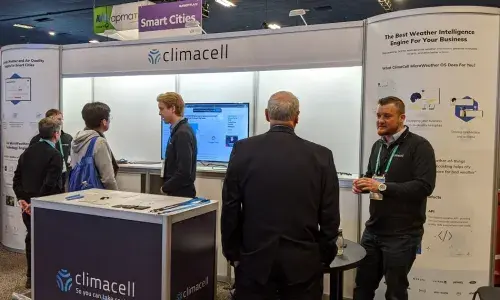
Bringing disruption upon ourselves
Over the last year, I’ve written about disruption. How it can blindside the biggest companies and put them out of business – and how we’ve invested to ensure that doesn’t happen to National Grid.
With that effort, underway – our $102 million portfolio has stakes in 18 firms – I want to close out this series by focusing inward. Specifically, I want to detail how we’re disrupting the operations and culture at National Grid – and how we plan to do the same for the broader energy and utility markets.
Putting Our Investments To Work…For Us
We recently opened an incubation office in San Francisco to tap into Silicon Valley’s talent pool. Our CEO, John Pettigrew, was on hand to meet with startup founders and the media. He could not have been clearer as to why we’re focused on our own disruption.
“Delivering energy and sending customers a bill is not going to be enough going forward, and we have to adapt to that reality,” he said.
Part of that adaptation is making direct investment in startups whose technologies can transform our operations. Consider customer service, which is the most important part of what we do. Instead of phone-tree navigation during business hours, people today want voice-driven access from their mobile phones or smart home devices, at whatever time they find convenient, and in many more languages than we support today.
That’s why we invested in Uniphore, which provides digital conversational assistance in more than 100 languages – intelligent help that not only understands what our customers are saying but the context, emotion, and sentiment behind how they’re saying it.
On the distribution front, we recently reinvested in Leap and relocated them within our San Francisco office to accelerate their growth. Leap’s sophisticated technologies back a deceptively simple idea: providing a clearinghouse that matches energy buyers with sellers and letting the best bid win. We’re currently running a proof-of-concept pilot project with Leap to evaluate its potential to transform our US Core Gas business.
Two other companies new to our portfolio have capabilities that are exciting for utilities like ours. Spark Cognition uses artificial intelligence to predict failures of turbines and other electricity-generation equipment – failures that would otherwise go undetected and cause catastrophic downtime. And CNI Guard makes a range of sensors to spot threats to utility infrastructures. It can detect when a worn power line has electrified a manhole cover; a utility pole is sagging dangerously; a gas distribution system is leaking; and when someone is trying to break through an access door, tank lid, or facility gate.
Today, we have deployed almost a half dozen of our portfolio’s technologies across the US Core, UK Core, and corporate and finance operations. It’s exactly what our CEO expects.
“When I talk to my team, I talk about moving from an analog experience to a digital one – and that means we have to embrace technology,” John said.
A Shift In Mindset
Human beings are social creatures. We’re drawn to various groups. Those groups have behavioral patterns and expectations that, together, make up a culture. Your city, workplace – even your local pub – all have their own cultures.
Historically, utilities have enjoyed a steady-as-she-goes culture: electricity is delivered, bills are sent and paid, rate structures are filed with regulators – all using well-understood technologies and cost assumptions. It’s not that this approach was bad. But it’s inadequate for the challenges we face today. Just as Airbnb upended the hotel industry and Netflix changed the way we watch television, new companies of all stripes see our industry, and our customers, as ripe for the taking.
“With all the changes going on in the energy sector, the danger is that we become complacent and don’t respond to the needs of our customers,” John said.
With that reality in mind, we’ve launched two efforts to make our culture more entrepreneurial.
The first is our Disruptive Innovation Center of Excellence. The goal is to take the unmatched knowledge we have inside our walls and use it to disrupt ourselves before someone else. We launched the center in the Spring with the enthusiastic support of our business unit leaders; since then, we have already vetted 162 new ideas ranging from customer service and energy distribution and transmission to procurement, finance and business services. As of this writing we’re looking deeply at 12 ideas – and expect to have vetted more than 300 brand-new ideas by the end of 2020.
The second effort is to incubate enthusiasm for innovation and disruption in our next generation of leaders. To do so, we launched the Venture Fellowship Program. This apprenticeship program is an opportunity for employees to accelerate their entrepreneurial capabilities under the mentorship of venture capitalists and innovation leaders from the energy sector, then take back to their businesses what they’ve learned. In that way, we build an entrepreneurial culture from within.
Laying The Groundwork For Industry-Wide Disruption
We are the first utility to launch its own investment and innovation fund in Silicon Valley. However, we’re not the only one that understands how the industry is changing in fundamental ways. I talk with utility leaders on a regular basis and, trust me, everyone knows disruption is barreling down on us.
The challenge is how to respond. Traditional utilities and energy providers have little experience working with startup companies. And from the outside looking in, we appear to be a mismatched set: while utilities tend to move with caution and an eye toward regulation, startups come from a tradition of moving fast and breaking things.
Clearly both groups need to understand how each operates and find ways to work together. That’s why we formed the Next Grid Alliance. Composed of utilities that don’t compete because of non-overlapping geographies, it’s an opportunity to share best practices, develop new ways of working with the startup community, and even co-invest in new ventures.
As of this writing, 14 utilities have agreed to take part in the Next Grid Alliance. We’ll start with regular meetings, then build quickly toward members-only innovation bootcamps; thematic programming around such topics as the future of heat, the path to decarbonization, and electrifying transportation; and technology showcases for portfolio companies to detail what they do and the benefits they can provide.
We’re All On The Clock
From my two decades of experience as a technology investor, I can tell you that once an industry gets in the sights of disruptors, things move very quickly. That is why we’re making investments, running pilot programs, and championing a culture of entrepreneurship. As John said during his trip to San Francisco, our collective job is to future-proof National Grid so that we’re as relevant in five years as we are today.
Clock’s ticking.
I am the Chief Technology and Innovation Officer of National Grid, a multinational electricity and gas utility company and am the Founder and President of National Grid Partners, the innovation and investment arm for National Grid. I sit on the NVCA Board of Directors, where I am co-chair of the Venture Forward initiative. I was a Managing Partner at the Westly Group, responsible for investments in energy, software, and IoT and a Vice President at Intel Capital and the Managing Director of Intel Capital’s Software and Services Group and the Intel Capital Diversity Fund. I am the founder and CEO of a non-profit called UPWARD, which is a global network for advancing professional women.


